CLINICAL,FORENSIC,AND ETHICS CONSULTATION IN MENTAL HEALTH
Oxybutynin
"Buy generic oxybutynin 5 mg, symptoms urinary tract infection".
By: L. Connor, M.B. B.CH., M.B.B.Ch., Ph.D.
Medical Instructor, University of California, Merced School of Medicine
Prolonged high doses of corticosteroids medications 4 less purchase oxybutynin australia, as nicely as radiation therapy medications ocd discount 2.5 mg oxybutynin with mastercard, induce lenticular opacities in some patients symptoms 8-10 dpo discount oxybutynin line. Subluxation of the lens medications vaginal dryness purchase oxybutynin with amex, the outcomes of weakening of its zonular ligaments, occurs in syphilis, Marfan syndrome (upward displacement), and homocystinuria (downward displacement). In the vitreous humor, hemorrhage could occur from rupture of a ciliary or retinal vessel. On ophthalmo scopic examination, the hemorrhage appears as a diffuse haziness of half or the entire vitreous or, if the blood is between the retina and the vitreous and displaces the lat ter rather than mixing with it, takes the type of a sharply defined clot. The most common vitreous opacities are benign "floaters" attributable to the condensation of vitreous collagen fibers, which seem as darting grey flecks or threads with modifications in the position of the eyes; they might be annoying or even alarming until the individual stops looking for them. A sudden burst of flashing lights associated with an increase in floaters might mark the onset of retinal detach ment. Patients complaining of shiny flashes and spots in imaginative and prescient should be examined with the indirect ophthal moscope to rule out tears, holes, or detachments of the vitreous or retina. Another common prevalence with advancing age is shrinkage of the vitreous humor and retraction from the retina, causing persistent streaks of light, often within the periphery of the visual field. These phosphenes, also called Moore lightning streaks, had been thought to be fairly benign, however they could at instances, indicate incipient retinal or vitreous tears or detachment, and their first look requires immediate analysis by an ophthalmologist. They are most outstanding on move ment of the globe, on closure of the eyelids, at the moment of accommodation, with saccadic eye actions, and with sudden publicity to dark. The time period uveitis refers to an infective or noninfec tive inflammatory disease that impacts any of the uveal structures (iris, ciliary body, and choroid). According to Bienfang and colleagues, uveitis accounts for 10 per cent of all cases of legal blindness within the United States. The irritation could also be within the anterior a half of the eye or within the posterior part, behind the iris and extending to the retina and choroid. Visual stimuli getting into the eye traverse the inside layers of the retina to attain its outer (posterior) layer, which incorporates two classes of photoreceptor cells: the flask-shaped cones and the slender rods. The photore ceptors rest on a single layer of pigmented epithelial cells, which kind the outermost surface of the retina. The rod cells contain rhodopsin, a conjugated protein in which the chromophore group is a carotenoid akin to vitamin A. The rods operate within the perception of visible stimuli in subdued mild (twilight or scotopic vision), and the cones are answerable for shade discrimination and the percep tion of stimuli in brilliant gentle (photopic vision). Most of the cones are concentrated within the macular area, par ticularly in its central part, the fovea, and are liable for the very best stage of visual acuity. Traquair described the rapid fall-off of acuity as the distance from the fovea increases as " an island of vision in a sea of blindness. The axons of the retinal ganglion cells, as they stream throughout the internal surface of the retina, pursue an arcuate the axons of ganglion cells are collected in the optic discs after which cross uninterruptedly via the optic nerves, optic chiasm, and optic tracts. The fibers derived from macular cells type a discrete bundle that first occupies the temporal side of the disc and optic nerve and then assumes a more central place inside the nerve (papillomacular bundle). These fibers are of smaller caliber than the peripheral optic nerve fibers and appear to be especially delicate to poisonous and metabolic injury. Damage to the papillomacular bundle produces the "cecocentral" scotoma (extending from fixation to the blind spot). Thus, interruption of the left optic fluorescein retinography reveals a trace of their outlines; an skilled examiner, using a bright light and deep green filter, can visualize them by way of direct ophthalmoscopy. Light coming into the attention anteriorly passes via the total thlckness of the retina to attain the rods and cones (first system of retinal neurons). Impulses arising in these cells are transmitted by the bipolar cells (second system of retinal neu rons) to the ganglion cell layer. The third system of visible neu rons consists of the ganglion cells and their axons, which run uninterruptedly through the optic nerve, chiasm, and optic tracts, synapsing with cells in the lat eral geniculate physique. Diagram showing the results on the fields of imaginative and prescient produced by lesions at numerous factors alongside the optic pathway. The traditional effect is a left-junction scotoma in affiliation with a right higher quadrantanopia. Right superior and inferior quadrant hemianopia from interruption of visual racliations. Lesions at the junction of the optic nerve and chiasm, generally compressive in nature, could trigger a small contralateral superotemporal qua drantic defect in addition to the expected central scotoma in the ipsilateral eye ("junctional scotoma,".
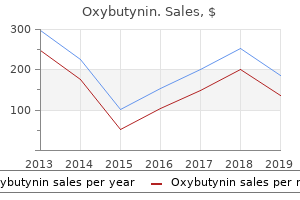
The clinical par ticulars of these and different forms of syncope are described additional on medicine lake mt oxybutynin 2.5mg otc. Neurogen ic Syncope this time period refers to all forms of syncope that end result directly from the vascular effects of neural alerts coming from the central nervous system treatment zinc poisoning safe 2.5mg oxybutynin. In essence medications enlarged prostate buy oxybutynin once a day, all the types of syncope in this category are "vasovagal symptoms exhaustion buy oxybutynin 5 mg low cost," which means a com bination of vasodepressor and vagal effects in varying proportions; the only variations are within the stimuli that elicit the reflex response. A number of stimuli, largely from the viscera however a few of psychologic or emotional origin, are able to eliciting this response, which consists of a reduction or lack of sympathetic vascular tone coupled with a height ened vagal activity. By the use of rnicroneurograpy, Wallin an Sundlof have demonstrated a rise m sympathetic outflow in peripheral nerves just previous to syncope, as would be expected; nonetheless, this exercise then eaes on the onet of fainting. Unmyelinated (postganglio sympathec) fibers cease firing during vasovagal famting at a pomt when the blood strain falls beneath 80/40 mm Hg and the pulse, below 60. Moreover, in the identical R atients, the response of the cardiac baroreceptors to pooling was significantly diminished. There is agreement that peripheral vascular resiS tance is tremendously lowered just previous to and at th onset of fainting. This drop in resistance has been attributed to an preliminary adrenergic discharge that, at excessive ranges, causes a vasodilatation (rather than constriction) in intramus cular blood vessels. High levels of epinephrine and the vasodilating results of nitric oxide appearing on vascular endothelium, in addition to greatly augmented ranges of circulating acetylcholine throughout syncope, even have been invoked as further or middleman components, however all stay speculative. It has been additional advised, on the premise of purpose in a position but inconclusive physiologic proof, that the early sympathotonic attempt to keep blood stress leads to overly vigorous contractions of the cardia chambers and that this, in flip, acts as the afferent strmulus for withdrawal of sympathetic tone in widespread fainting (see "Neurocardiogenic Syncope," later). Norcliffe-Kaufmann and colleagues recorded a higher than-normal discount in cerebral blood flow velocity (gauged by transcranial Doppler) and an excessively. They relate the degree of those modifications to vanations m orthostatic tolerance amongst patients and counsel that the two aforementioned changes relate to decreased cerebral blood move that will engender syncope. As mentioned earlier, it might be the ultimate precipitant in the frequent va odepressor faint, and the term is used synonymously with vasovagal or vasodepressor syncope by some authors. Oberg and Thoren had been the primary to observe tha the left ventricle itself may be the supply of neurally mediated syncope in a lot the same way because the carotid sinus when. This idea of the heart as the afferent supply of vasodepressor reflexes had been suggested earlier by Bezold, as nicely as by Jaris0 and Zoterm, and got here to be generally known as the Bezold-Jansch reflex. For this mechanism to turn out to be active, very vigor ous cardiac contractions must happen in the presence of poor filling of the cardiac chambers (hence "neu rocardiogenic"). In the straightforward faint, an al burst f sympathetic exercise is believed to prCipitate physi. Echocardiographic findings of a dlffimlshed ventricular chamber dimension and vigorous contractions simply previous to syn cope support this notion (the "empty-heart syndrome"). The remaining baroreceptors in the aorta may be respon sible for the increased afferent activity. According to Kaufmann, a proclivity to primary neu rocardiogenic syncope can be identified by the discovering of delayed fainting when the patient is positioned at 60-degree upright place on a tilt table. In distinction, patients with main sympathetic failur will faint oon after upward tilting. The value of isoproterenol as a cardiac stimu lant and peripheral vasodilator to improve the impact of upright posture and expose neurocardiogenic syncope through the tilt-table take a look at is controversial. For this cause, these sufferers might benefit from beta-adrenergic-blocking medication if given beneath cautious supervision. Athletes who faint unpredictably during exercise pose a very difficult downside. Obviously these discovered to have critical coronary heart disease should give up com petitive sports, but the majority has no demonstrable cardiac abnormality. Subjecting these patients to intense train and other testing typically fails to elicit the faints, however many have various levels of hypotension when subjected to prolonged head-up tilt, again suggest ing that the cause of fainting is actually neurocardio genic (see above). Here, the reflex bradycar dia is extra typically of sinoatrial than atrioventricular type. Through an identical mechanism, tumors or lymph node enlargements on the base of the skull or in the neck that impinge on the carotid artery, in addition to postradiation fibrosis, are able to causing dramatic syncopal attacks, sometimes preceded by unilateral head or neck ache.
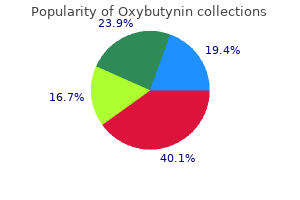
Electromyography of the orbicularis oculi reveals two components of the blink response nioxin scalp treatment discount 2.5 mg oxybutynin mastercard, an early and late one medications on airplanes oxybutynin 5mg on line, options that are readily corroborated by clinical statement treatment advocacy center order oxybutynin with mastercard. The early response consists of solely a slight movement of the higher lids; the instantly following response is more forceful and approximates the higher and decrease lids treatment as prevention buy 5 mg oxybutynin with visa. Whereas the early a half of the blink reflex is past volitional management, the second part may be inhib ited voluntarily. There can also be a congenital and sometimes hereditary anomaly in which a ptotic eyelid retracts momentarily when the mouth is opened or the jaw is moved to one aspect. In different instances, inhibition of the levator muscle and ptosis occurs with opening of the mouth ("inverse Marcus Gunn phenomenon," or Marin Amat syndrome). A helpful medical rule is that a mixed paralysis of the levator, and orbicularis oculi muscles. This is because the third and seventh cranial nerves are rarely affected collectively in peripheral nerve or brainstem illness. An infrequent but ignored cause of unilateral static ptosis is a dehiscence of the tarsal muscle attachment; it can be identified by the loss of the upper lid fold j ust below the brow. Bilateral ptosis is a characteristic characteristic of sure muscular dystrophies and of myasthenia gravis; congeni tal ptosis and progressive sagging of the upper lids in the elderly are different frequent varieties as well botulism whether or not naturally acquired of after botulinum toxin therapies. An effective way of demonstrating that gentle ostensibly unilateral ptosis is in reality bilateral is to carry the ptotic facet and observe that the opposite lid promptly droops. Unilateral ptosis is a notable feature of third nerve lesions (see above) and of sympathetic paralysis, specifically, the Horner syndrome. It could also be accompanied by an overaction (compensation) of the frontalis and the contralateral levator palpebrae muscle tissue. Brief fluttering of the lid mar gins upon moving the eyes vertically is also attribute of myasthenia. Increased blink frequency is a delicate part of the same condition but also occurs with corneal irritation. The reverse sign, reduced frequency of blinking (< 1 0 / min), is characteristic of progressive supranuclear palsy and Parkinson illness. In these circumstances, adaptation to repeated supraorbital tapping at a fee of about 1 / s is impaired; therefore the affected person continues to blink with every tap on the forehead or glabella, referred to as the glabellar, or retraction of the upper lids, with a staring expression (Collier sign) is noticed with orbital tumors and in thyroid disease, the latter also being the commonest explanation for unilateral and bilateral proptosis. A staring appearance alone is observed in Parkinson illness, progressive supranuclear palsy, and hydrocephalus in younger youngsters, in which there could also be downturning of the eyes ("sunset signal"), and paralysis of upward gaze. Slight lid retraction has been observed in a couple of sufferers with hepatic cirrhosis, Cushing disease, chronic steroid myopathy, and hyperkalemic periodic paralysis. Lid retraction is normally a response to ptosis on the other facet; that is clarified by lifting the ptotic lid manually, and observing the disappearance of contralateral retraction as talked about above. In myotonia congenita, forceful closure of the eyelids might induce a powerful aftercontrac tion. A lesion of the facial nerve, as in Bell palsy, leads to an lack of ability to close the eyelids because of weakness of orbicularis oculi, retraction of the upper lid (as a result of the unopposed action of the levator), and loss of the blink reflex on the affected facet. In some situations of Bell palsy, even after practically full restoration of facial movements, blink frequency and amplitude may be decreased on the previously paralyzed side. Aberrant regeneration of the third nerve after an injury could lead to a situation whereby the higher lid retracts on lateral or downward gaze (pseudo-von Graefe sign). Acute proper parietal or bifrontal lesions typically pro duce a peculiar disinclination to open the eyelids, even to the purpose of offering energetic resistance to compelled opening. The closed lids give the false impression of diminished alertness and has incorrectly been called an apraxia of lid opening. Essential, in fact, is the right interpretation of pupil lary reactions, and this requires some data of their underlying neural mechanisms. The diameter of the pupil is decided by the b al ance of innervation between the constricting sphincter and radially organized dilator muscle tissue of the iris, the sphincter muscle taking half in the major function in the light response. The postganglionic fibers then enter the globe through the short ciliary nerves; roughly which originate in the retinal receptor cells, pass via the bipolar cells, and synapse with the retinal ganglion cells; axons of these cells run within the optic nerve and within the ipsilateral tract. The gentle reflex fibers depart the optic tract just rostral to the lateral geniculate body and enter the high mid-brain, the place they synapse within the pretectal nucleus.
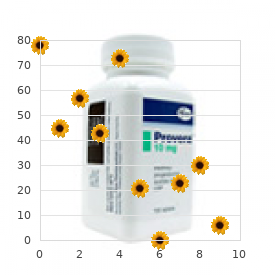
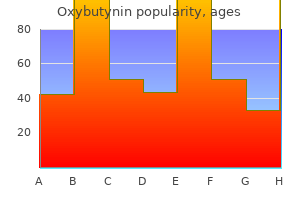
The major somatosensory pathways emphasizing the posterior column-lemniscal system (thicker tract lines) medicine mound texas generic oxybutynin 2.5mg online. The dorsal horn cells symptoms zoloft withdrawal order cheapest oxybutynin, in turn symptoms of anxiety discount oxybutynin amex, give rise to secondary sensory fibers treatment wetlands purchase oxybutynin 5mg otc, some of which may ascend ipsilaterally but most of which decussate and ascend in the spino thalamic tracts, as described in Chap. Observations based mostly on surgical interruption of the anterolateral funiculus indicate that fibers mediating contact and deep stress occupy the ventromedial part (anterior spinothalamic tract). The lemniscal system is situated in a medial to the descending corticospinal system. After getting into the pons, the ache and tempera ture fibers flip caudally and run by way of the ipsilateral medulla because the descending spinal trigeminal tract, termi nating within the lengthy, vertically oriented nucleus caudalis, or spinal trigeminal nucleus, that lies beside it and extends to the second or third cervical phase of the cord, where it becomes steady with the posterior horn of the spi nal grey matter. Axons from the neurons of this nucleus cross the midline and ascend because the trigeminal quintotha lamic tract (also termed, somewhat imprecisely, trigemi nal lemniscus) alongside the medial aspect of the spinothalamic tract. The first area (Sl) corresponds to the submit central cortex or Brodmann areas 3, 1, and a pair of. Electrical stimulation of this area yields sensations of tingling, numbness, and warmth in specific regions on the opposite aspect of the body. The info transmitted to Sl is tactile and proprioceptive, derived primarily from the dorsal column-medial lemniscus system and anxious mainly with sensory discrimination. The second somatosensory space (S2) lies on the higher financial institution of the sylvian fissure, adjoining to the insula. Localization of operate is much less discrete in S2 than in Sl, however S2 is also organized somatotopically, with the face rostrally and the leg caudally. The sensations evoked by electrical stimulation of S2 are much the identical as these of Sl however, in distinction to the latter, may be felt bilaterally. Undoubtedly, the perception of sensory stimuli involves more of the cerebral cortex than the two discrete areas described above. Some sensory fibers probably proj ect to the precentral gyrus and others to the superior pari etal lobule. This reciprocal arrangement probably influences motion and the transmission and interpretation of ache, as discussed in Chap. The "sensory homunculus," or cortical representation of sensation in the postcentral gyrus; evaluate this to the distribution of physique areas within the motor cortex as shown in. This medical distinction is elaborated within the discussion of the sensory syndromes additional on. Most external and a few inside stimuli are extremely complicated and induce exercise in multiple sensory system. It is also truthful to say that few diagnoses are made solely on the basis of the sensory examination; extra often the exercise serves to complement the motor examination. Quite usually, no objective sensory loss may be demonstrated regardless of signs that suggest the presence of such an abnormality. Sensory symptoms within the nature of paresthesia or dyses thesia may be generated along axons of nerves not suffi ciently diseased to impair or reduce sensory perform; in the latter occasion, loss of operate could have been so delicate and gradual as to pass unn oticed. Before continuing to sensory testing, the doctor should question sufferers about their signs; this, too, poses particular problems. More often, disease induces new and unnatural sensory experi ences such as a band of tightness, a feeling of the feet being encased in cement, lancinating pains, an unnatural feeling when stroking the pores and skin, a sensation as if strolling on pebbles, and so on. If nerves, sensory roots, or spinal tracts are dam aged or partially interrupted, the affected person may complain of tingling or prickling emotions ("like Novocain" or like the sentiments in a limb that has "fallen asleep," the com mon colloquialism for nerve compression), cramp-like sensations, or burning or slicing ache occurring both spontaneously or in response to stimulation. Experimental knowledge help the view that partially broken touch, pressure, thermal, and ache fibers become hyperexcitable and generate ectopic impulses along their course, both spontaneously or in response to a natural volley of stimulus-evoked impulses (Ochoa and Torebjork). Another positive sensory symp tom is allodynia, referring to a phenomenon by which one type of stimulus evokes one other sort of sensation-e. Paresthesia, tingling, buzzing Burning, heat, cold Prickling pain Pseudocramp Band tightness Lancinating ache Hyperalgesia Large fibers (in nerve or posterior columns) Small fibers Combined small- and large-fiber A type of paresthesia, probably related to large-fiber dysfunction Lenutiscal system of twine Small-fiber neuropathy and radiculopathy Partial peripheral nerve damage General Considerations the medical description of a sensation may divulge the particular sensory fibers involved (Table 9-1). It is known that stimulation of contact fibers offers rise to a sensation of tingling and buzzing; of muscle propriocep tors, to pseudocramp (the sensation of cramping without actual muscle contraction); of thermal fibers, to warmth (including burning) and coldness; and of A-o fibers, to prickling and pain. Paresthesia arising from ectopic dis expenses in giant sensory fibers could be induced by nerve compression, hypocalcemia, hypomagnesemia, sure drugs (niacin foremost amongst them), and various illnesses of nerves.
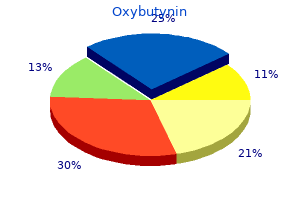
Also treatment esophageal cancer buy oxybutynin 2.5mg with visa, an increased sleep-associated secretion of luteinizing hormone occurs in pubertal boys and girls symptoms 2dpo buy generic oxybutynin pills. A refinement of these views has elaborated the advanced interaction of specifically functioning nuclei in the hypothalamus treatment multiple sclerosis generic oxybutynin 5 mg with mastercard, pons treatment modality definition purchase cheapest oxybutynin, and basal forebrain. Reciprocal connections amongst these areas, modulated by enter from areas of the mind that sense environmental circumstances, allow the organism to adapt sleep cycles to its wants and to external circumstances. The above-described interconnections and the action of the integrated system that causes the sleep state have been summarized by Saper and colleagues and schemati cally in. The orexin neurons act via the monoaminergic system as a stabilizing influence to forestall rapid transitions from one state to the other. Cholinergic n eurons are present in two main loci in the parabrachial region of the dor solateral pontine tegmentum-in the pedunculopontine group of nuclei and the lateral dorsal tegmental group. The cholinergic cell teams project rostrally, but the exact anatomy of this projection system has not been defined. Cells from these teams make up components of the ascending reticular activating system. Single-cell recordings from the pontine reticular formation counsel that there are two interconnected neuronal populations whose levels of exercise fluctuate periodically and recip rocally. During wakefulness, according to this conceptu alization, the activity of aminergic (inhibitory) neurons is high; because of this inhibition, the activity of the cho linergic neurons is low. Hypocretin, a peptide that assumes great importance in the pathophysi ology of narcolepsy, is mentioned additional on. Thi s inhibits the orexin neurons, fur ther stopping monoaminergic activation which may interrupt sleep. Insofar as the majority of cholinergic and aminergic neu rons are found in the pedunculopontine group of nuclei, Shiromani and colleagues have advised that interplay between these neurons happens in the region of the pedun culopontine nuclei somewhat than within the medial pontine retic ular formation, as instructed by Hobson and associates. Solms has proposed that the dopaminergic techniques in the basal forebrain areas elicit or modulate dreaming. This view is supported by reviews of diminished dream ing in patients being handled with dopaminergic blockers and the enhancement of dreaming reported by patients taking L-dopa or dopamine agonsits. Notable on this regard is the truth that main intracortical dopaminergic pathways originate in the frontal lobes. Most of the integrated rhythms of sleep which would possibly be recorded at the floor of the brain, including the background exercise of slow-wave sleep and the faster and more synchronized sleep spindles and vertex waves, have their origins in the thalamus. Steriade and colleagues have performed a considerable quantity of the fashionable work in this area and s umm a rize it in their review. The Fu nction of Sleep and D rea ms these questions have been contemplated endlessly by physi ologists and psychiatrists (and philosophers). Based on these and comparable studies, a quantity of authors have speculated that the suppression of frontal lobe exercise throughout dreaming, at a time when visible affiliation areas and their paralimbic connections are activated, would possibly clarify the uncritical acceptance of the weird visual content material, the disordered temporal relationships, and the heightened emotionality that characterize desires. As an alternate that links desires to inherent meaning for the individual, Solrns advised that activation of frontal doparninergic methods throughout dreaming, the identical pathways that partic ipate in most biologic drives, implies that desires express latent needs and drives-a psychoanalytical interpreta tion expressed by Freud in his guide the Interpretation of Dreams. Nevertheless, humans beings deprived of sleep do suffer quite so much of very disagreeable symptoms quite distinct from the effects of the standard kinds of insomnia. Despite many research of the deleterious emotional and cognitive effects of sleeplessness, we nonetheless know little about them. Self-care is uncared for, incentive to work wanes, sustained thought and action are interrupted by lapses of attention, judg ment is impaired, and the subject turns into decreasingly inclined to communicate. With sustained deprivation, sleepiness turns into more and more extra intense, momen tary durations of sleep ("microsleep") turn out to be extra intru sive, and the tendency to all types of accidents turns into more marked. Eventually, topics fail to perceive inne r and exterior experiences accurately and to preserve their orientation. Illusions and hallucinations, mainly visual and tactile ones, intrude into consciousness and turn out to be more persistent as the interval of sleeplessness is prolonged. This could also be a element of the decompen sation of people with bipolar psychiatric disease, generally triggering manic episodes. Neurologic signs of sleep deprivation include a gentle and inconstant nystagmus, impairment of saccadic eye movements, loss of lodging, exophoria, a slight tremor of the hands, ptosis of the eyelids, expressionless face, and thickness of speech, with mispronunciations, and incorrect alternative of words. Rarely and doubtless solely in predisposed individuals, loss of sleep provokes a psychotic episode (2 to 3 % of 350 sleep disadvantaged sufferers studied by Tyler); however, many sleep specialists dispute the production of psychosis. This might be a results of the intrusion of temporary sleep durations through the waking state and repre sents a large amount of time if s ummated (it is virtually unimaginable to deprive a human being or animal completely of sleep). N3 appears to be crucial sleep stage in restor ing the altered capabilities that outcome from extended sleep deprivation.
Purchase 5mg oxybutynin otc. When You Google Your Symptoms....
